Digital learning resources play a crucial role in enhancing skills and credibility within the education technology sector. To ensure quality, it is essential to consider factors such as accreditation, user feedback, and course content, which help verify the effectiveness and alignment of these resources with your learning objectives.
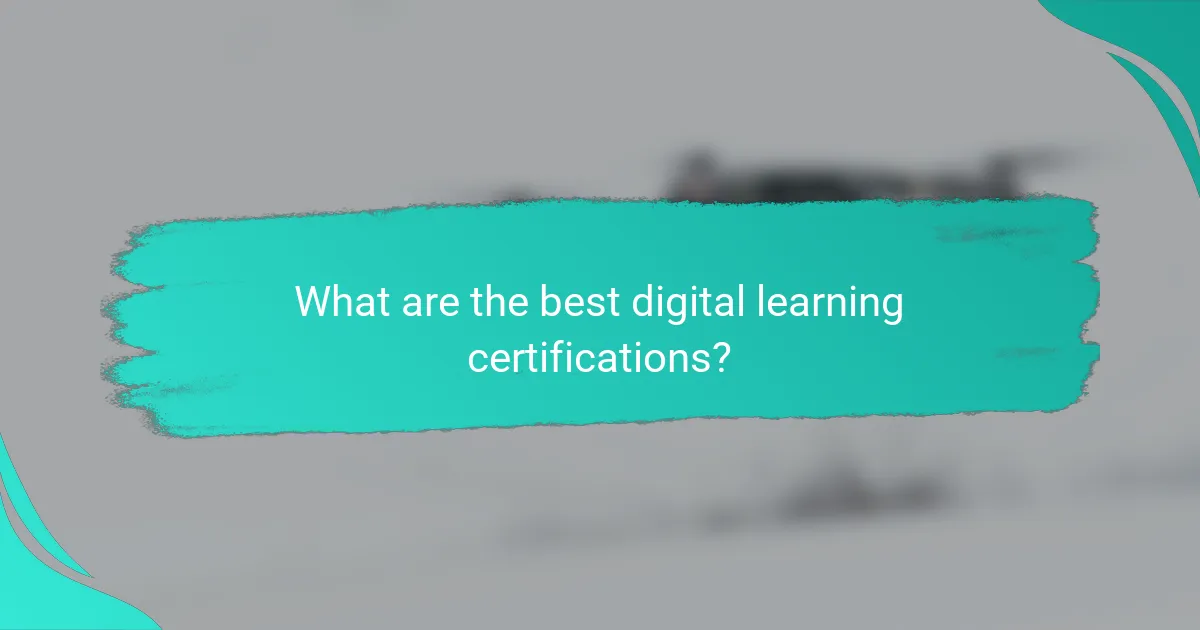
What are the best digital learning certifications?
The best digital learning certifications enhance your skills and credibility in the education technology sector. They are recognized globally and can significantly improve your job prospects and professional development.
Google Certified Educator
The Google Certified Educator program offers two levels of certification, focusing on using Google tools effectively in educational settings. Level 1 is for educators who want to integrate Google tools into their teaching, while Level 2 is for those who wish to deepen their skills and lead others in using these tools.
To earn this certification, candidates must pass an exam that tests their knowledge of Google Workspace for Education. Preparation resources include online courses and practice exams available through Google and various educational platforms.
Microsoft Certified Educator
The Microsoft Certified Educator certification is designed for educators who want to demonstrate their proficiency in using Microsoft tools in the classroom. This certification focuses on the integration of technology into teaching and learning processes.
To obtain this certification, candidates must complete a training course and pass an exam. The program emphasizes practical skills, so hands-on experience with Microsoft 365 tools is highly beneficial for success.
Adobe Certified Associate
The Adobe Certified Associate (ACA) certification validates your skills in Adobe Creative Cloud applications, such as Photoshop, Illustrator, and InDesign. This certification is ideal for those looking to enhance their digital media skills in educational or professional contexts.
To achieve ACA certification, candidates must pass an exam that assesses their knowledge of Adobe tools and their application in real-world scenarios. Preparation can include online courses, study guides, and practice tests offered by Adobe and other training providers.
CompTIA IT Fundamentals
The CompTIA IT Fundamentals certification provides a foundational understanding of IT concepts and practices. It is suitable for those new to the field of information technology and serves as a stepping stone to more advanced IT certifications.
To earn this certification, candidates must pass a single exam covering topics such as hardware, software, networking, and security. This certification is valuable for educators teaching IT courses or for anyone looking to enter the tech industry.
Amazon Web Services Certified Cloud Practitioner
The AWS Certified Cloud Practitioner certification is designed for individuals who want to demonstrate their understanding of AWS cloud services. This entry-level certification is suitable for educators and professionals who are new to cloud computing.
To obtain this certification, candidates must pass an exam that tests their knowledge of AWS services, billing, and security. Preparation resources include AWS training courses, whitepapers, and practice exams available through the AWS website and other educational platforms.
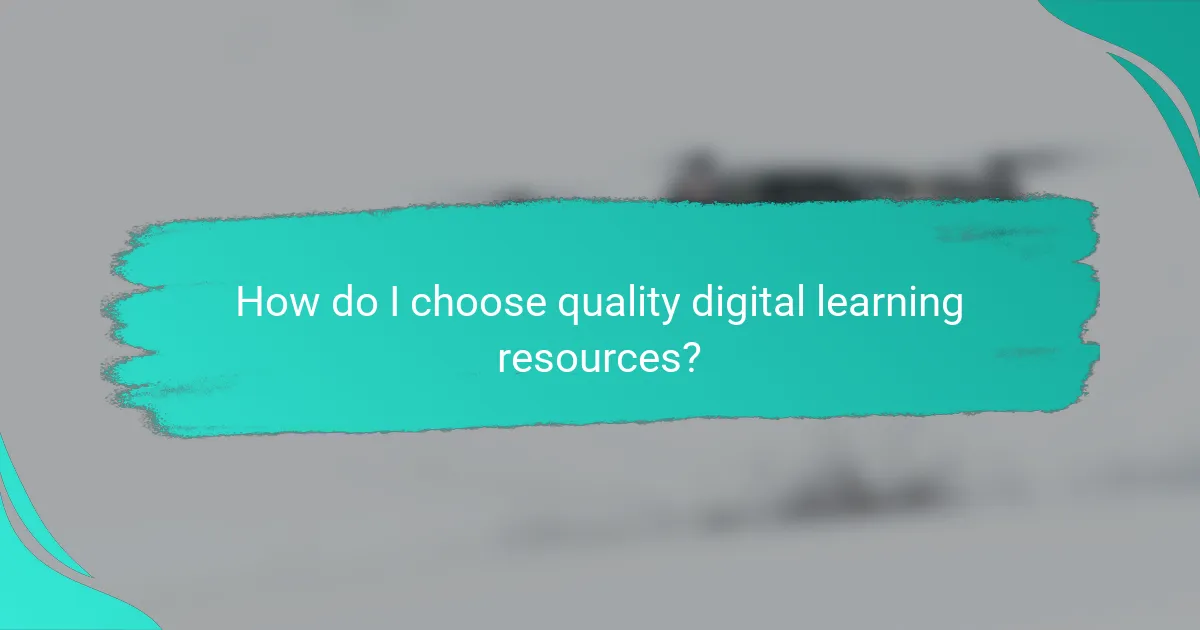
How do I choose quality digital learning resources?
To choose quality digital learning resources, focus on their accreditation, user feedback, and course content. These factors help ensure that the resources are credible, effective, and aligned with your learning goals.
Assess accreditation status
Checking the accreditation status of digital learning resources is crucial. Accredited programs meet established educational standards, which can enhance the value of your learning experience and improve job prospects.
Look for accreditations from recognized organizations or institutions. For example, in the United States, accreditation from the Council for Higher Education Accreditation (CHEA) or the U.S. Department of Education is a strong indicator of quality.
Review user testimonials
User testimonials provide insights into the effectiveness and quality of digital learning resources. Reading reviews can reveal strengths and weaknesses that may not be apparent from promotional materials.
Seek out testimonials from a diverse range of users to get a balanced view. Pay attention to comments about course relevance, instructor quality, and overall satisfaction. Websites like Course Report or Trustpilot can be useful for finding authentic reviews.
Compare course content
Comparing course content is essential to ensure it aligns with your learning objectives. Look for detailed syllabi that outline topics covered, learning outcomes, and assessment methods.
Consider the depth and breadth of the material. Resources that offer a mix of theoretical knowledge and practical application tend to be more beneficial. Additionally, check for supplementary materials, such as quizzes or interactive elements, which can enhance the learning experience.
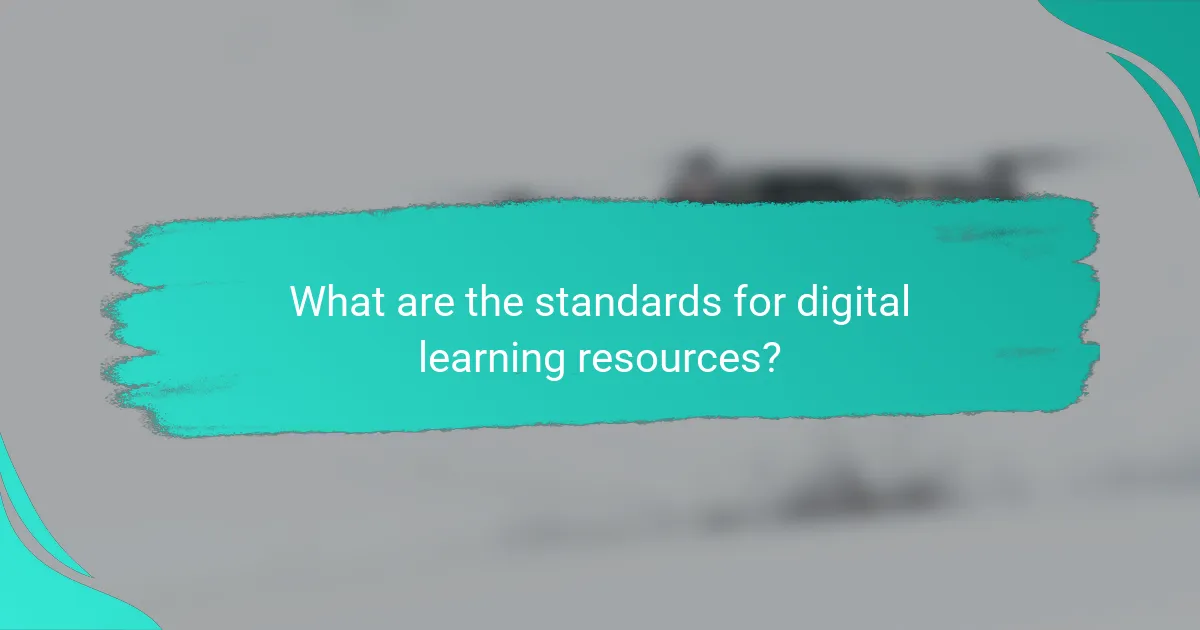
What are the standards for digital learning resources?
Standards for digital learning resources ensure quality and consistency in educational materials. They establish benchmarks for effectiveness, accessibility, and user experience, guiding developers and educators in creating impactful learning experiences.
ISO 21001:2018
ISO 21001:2018 is an international standard that specifies requirements for management systems in educational organizations. It focuses on improving the satisfaction of learners and other beneficiaries by enhancing the quality of educational services.
This standard emphasizes a learner-centered approach, promoting continuous improvement and stakeholder engagement. Organizations adopting ISO 21001:2018 can better align their educational offerings with the needs of learners and the demands of the market.
ANSI/ISO/IEC 17024
ANSI/ISO/IEC 17024 outlines the criteria for organizations that certify individuals in various professions, ensuring that the certification process is consistent and reliable. This standard is crucial for maintaining the credibility of certifications in digital learning environments.
By adhering to ANSI/ISO/IEC 17024, organizations can demonstrate that their certification processes are fair, transparent, and based on valid assessments. This builds trust among learners and employers, enhancing the value of the certifications offered.
Quality Matters Rubric
The Quality Matters Rubric is a set of standards designed to evaluate the quality of online and blended courses. It provides a framework for assessing course design, focusing on aspects such as learning objectives, assessment alignment, and learner engagement.
Using the Quality Matters Rubric helps educators identify areas for improvement in course design and delivery. Institutions often use this rubric to guide course development and ensure that their digital learning resources meet high-quality standards.
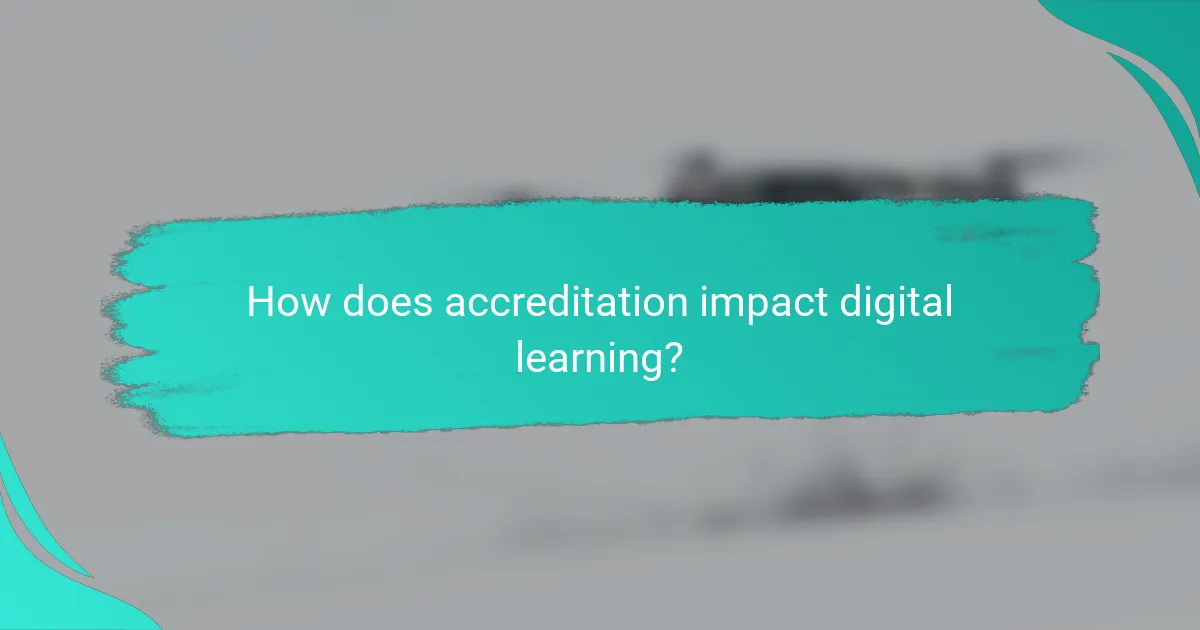
How does accreditation impact digital learning?
Accreditation significantly enhances digital learning by ensuring that educational programs meet established quality standards. It provides a framework for evaluating the effectiveness and credibility of online courses, which can influence student trust and institutional reputation.
Ensures quality and credibility
Accreditation serves as a benchmark for quality in digital learning, assuring students that the program meets specific educational standards. Accredited institutions often undergo rigorous evaluations, which can include assessments of curriculum, faculty qualifications, and student outcomes.
For example, a program accredited by a recognized body may be more appealing to prospective students, as it signals a commitment to quality education. This can lead to higher enrollment rates and improved student satisfaction.
Facilitates funding and partnerships
Accreditation can open doors to funding opportunities and partnerships with other educational institutions or organizations. Many grants and financial aid programs require that institutions hold proper accreditation, making it essential for securing financial support.
Additionally, accredited programs are more likely to attract partnerships with businesses and other educational entities, enhancing resources and opportunities for students. For instance, a partnership with a tech company may provide students access to internships and real-world projects, enriching their learning experience.
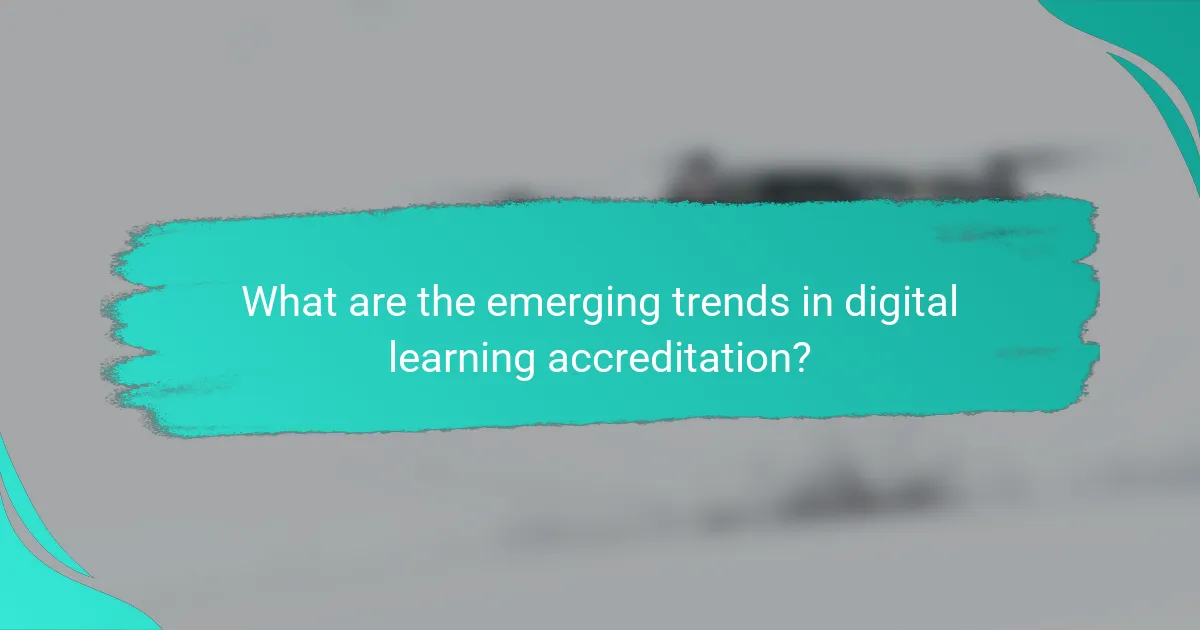
What are the emerging trends in digital learning accreditation?
Emerging trends in digital learning accreditation focus on enhancing the credibility and accessibility of educational credentials. Key developments include micro-credentialing, blockchain technology for verification, and personalized learning pathways that cater to individual needs.
Micro-credentialing growth
Micro-credentialing is gaining traction as a flexible way to recognize specific skills or competencies. These short, focused courses allow learners to earn certifications that demonstrate their expertise in niche areas, making them more attractive to employers.
Organizations are increasingly adopting micro-credentials to upskill their workforce efficiently. For instance, platforms like Coursera and edX offer a variety of micro-credentials in fields such as data science and digital marketing, often at a fraction of the cost of traditional degrees.
Blockchain for certification verification
Blockchain technology is revolutionizing the way certifications are verified, providing a secure and transparent method for credentialing. By storing credentials on a blockchain, institutions can ensure that the information is tamper-proof and easily accessible to employers and other stakeholders.
Several universities and organizations are piloting blockchain-based systems to issue and verify digital diplomas. This trend not only enhances trust in the certification process but also simplifies the verification process for job seekers, reducing the time and effort needed to prove their qualifications.
Personalized learning pathways
Personalized learning pathways are designed to tailor educational experiences to individual learners’ needs and goals. This approach allows students to progress at their own pace and focus on areas where they require more support or interest.
Many online learning platforms now offer adaptive learning technologies that adjust content based on a learner’s performance. For example, platforms like Khan Academy use algorithms to recommend resources and exercises, ensuring that learners receive a customized educational experience that aligns with their skills and aspirations.

What frameworks guide digital learning quality?
Several frameworks guide the quality of digital learning, ensuring that educational resources meet established standards. These frameworks provide structured approaches to designing, implementing, and evaluating digital learning experiences.
ADDIE Model
The ADDIE Model is a widely recognized framework in instructional design, consisting of five phases: Analysis, Design, Development, Implementation, and Evaluation. Each phase plays a critical role in creating effective digital learning experiences.
In the Analysis phase, identify the learning needs and objectives. During Design, outline the course structure and choose appropriate instructional strategies. Development involves creating the actual content, while Implementation focuses on delivering the course to learners. Finally, Evaluation assesses the effectiveness of the learning experience and informs future improvements.
For practical application, consider using checklists during each phase to ensure all elements are addressed. For instance, in the Design phase, include objectives, assessments, and content formats to streamline the process. Avoid common pitfalls like skipping the Evaluation phase, which can lead to missed opportunities for enhancement.
